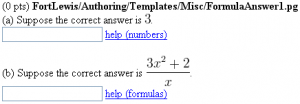Difference between revisions of "FormulaAnswer1"
Jump to navigation
Jump to search
(add historical tag and give links to newer problems.) |
|||
| (4 intermediate revisions by 2 users not shown) | |||
| Line 1: | Line 1: | ||
| − | <h2>Answer is a Number or a Formula - [https://test.webwork.maa.org/webwork2/Problem_Authoring_Techniques/T-PP-misc/1 Try it out]</h2> |
||
| + | {{historical}} |
||
| + | |||
| + | <p style="font-size: 120%;font-weight:bold">This problem has been replaced with [https://openwebwork.github.io/pg-docs/sample-problems/Misc/FormulaAnswer.html a newer version of this problem]</p> |
||
| + | |||
| + | |||
| + | <h2>Answer is a Number or a Formula - [https://testcourses.webwork.maa.org/webwork2/Problem_Authoring_Techniques/T-PP-misc/1 Try it out]</h2> |
||
[[File:FormulaAnswer1.png|300px|thumb|right|Click to enlarge]] |
[[File:FormulaAnswer1.png|300px|thumb|right|Click to enlarge]] |
||
| Line 5: | Line 10: | ||
This PG code shows how to write a question whose answer is a number or a formula. |
This PG code shows how to write a question whose answer is a number or a formula. |
||
</p> |
</p> |
||
| − | * Download file: [[File:FormulaAnswer1.txt]] (change the file extension from txt to pg when you save it) |
||
| + | <!--* File location in OPL: [https://github.com/openwebwork/webwork-open-problem-library/blob/master/OpenProblemLibrary/FortLewis/Authoring/Templates/Misc/FormulaAnswer1.pg FortLewis/Authoring/Templates/Misc/FormulaAnswer1.pg]--> |
||
| − | * File location in NPL: <code>FortLewis/Authoring/Templates/Misc/FormulaAnswer1.pg</code> |
||
| + | * PGML location in OPL: [https://github.com/openwebwork/webwork-open-problem-library/blob/master/OpenProblemLibrary/FortLewis/Authoring/Templates/Misc/FormulaAnswer1_PGML.pg FortLewis/Authoring/Templates/Misc/FormulaAnswer1_PGML.pg] |
||
<br clear="all" /> |
<br clear="all" /> |
||
| Line 16: | Line 21: | ||
<tr valign="top"> |
<tr valign="top"> |
||
| − | <th> PG problem file </th> |
+ | <th style="width: 50%"> PG problem file </th> |
<th> Explanation </th> |
<th> Explanation </th> |
||
</tr> |
</tr> |
||
| Line 42: | Line 47: | ||
DOCUMENT(); |
DOCUMENT(); |
||
| − | loadMacros( |
||
| + | loadMacros('PGstandard.pl','MathObjects.pl','PGML.pl','PGcourse.pl'); |
||
| − | "PGstandard.pl", |
||
| − | "MathObjects.pl", |
||
| − | "AnswerFormatHelp.pl", |
||
| − | ); |
||
TEXT(beginproblem()); |
TEXT(beginproblem()); |
||
| Line 64: | Line 65: | ||
<td style="background-color:#ffffdd;border:black 1px dashed;"> |
<td style="background-color:#ffffdd;border:black 1px dashed;"> |
||
<pre> |
<pre> |
||
| − | Context( |
+ | Context('Numeric'); |
$a = non_zero_random(-9,9,1); |
$a = non_zero_random(-9,9,1); |
||
| Line 86: | Line 87: | ||
<td style="background-color:#ffdddd;border:black 1px dashed;"> |
<td style="background-color:#ffdddd;border:black 1px dashed;"> |
||
<pre> |
<pre> |
||
| − | Context()->texStrings; |
||
| + | BEGIN_PGML |
||
| − | BEGIN_TEXT |
||
| + | Enter [`[$answer1]`]: [____]{$answer1} [@ helpLink('number') @]* |
||
| − | Enter \( $answer1 \): |
||
| + | |||
| − | \{ ans_rule(20) \} |
||
| + | Enter [`[$answer2]`]: [____]{$answer2} [@ helpLink('formula') @]* |
||
| − | \{ AnswerFormatHelp("numbers") \} |
||
| + | END_PGML |
||
| − | $BR |
||
| − | $BR |
||
| − | Enter \( $answer2 \): |
||
| − | \{ ans_rule(20) \} |
||
| − | \{ AnswerFormatHelp("formulas") \} |
||
| − | END_TEXT |
||
| − | Context()->normalStrings; |
||
</pre> |
</pre> |
||
<td style="background-color:#ffcccc;padding:7px;"> |
<td style="background-color:#ffcccc;padding:7px;"> |
||
<p> |
<p> |
||
<b>Main Text:</b> |
<b>Main Text:</b> |
||
| − | </p> |
||
| − | </td> |
||
| − | </tr> |
||
| − | <!-- Answer evaluation section --> |
||
| + | * The <tt>helpLink</tt> command show some additional help for entering values. |
||
| − | |||
| − | <tr valign="top"> |
||
| − | <td style="background-color:#eeddff;border:black 1px dashed;"> |
||
| − | <pre> |
||
| − | $showPartialCorrectAnswers = 1; |
||
| − | |||
| − | ANS( $answer1->cmp() ); |
||
| − | ANS( $answer2->cmp() ); |
||
| − | </pre> |
||
| − | <td style="background-color:#eeccff;padding:7px;"> |
||
| − | <p> |
||
| − | <b>Answer Evaluation:</b> |
||
</p> |
</p> |
||
</td> |
</td> |
||
| Line 128: | Line 107: | ||
<td style="background-color:#ddddff;border:black 1px dashed;"> |
<td style="background-color:#ddddff;border:black 1px dashed;"> |
||
<pre> |
<pre> |
||
| − | Context()->texStrings; |
||
| + | BEGIN_PGML_SOLUTION |
||
| − | BEGIN_SOLUTION |
||
| − | ${PAR}SOLUTION:${PAR} |
||
Solution explanation goes here. |
Solution explanation goes here. |
||
| − | END_SOLUTION |
||
| + | END_PGML_SOLUTION |
||
| − | Context()->normalStrings; |
||
| − | |||
| − | COMMENT('MathObject version.'); |
||
| − | |||
ENDDOCUMENT(); |
ENDDOCUMENT(); |
||
</pre> |
</pre> |
||
Latest revision as of 07:15, 17 July 2023
This problem has been replaced with a newer version of this problem
Answer is a Number or a Formula - Try it out
This PG code shows how to write a question whose answer is a number or a formula.
- PGML location in OPL: FortLewis/Authoring/Templates/Misc/FormulaAnswer1_PGML.pg
| PG problem file | Explanation |
|---|---|
|
Problem tagging: |
|
DOCUMENT();
loadMacros('PGstandard.pl','MathObjects.pl','PGML.pl','PGcourse.pl');
TEXT(beginproblem());
|
Initialization: |
Context('Numeric');
$a = non_zero_random(-9,9,1);
do { $b = random(2,9,1); } until ( $b != $a );
$answer1 = Compute("$a");
$answer2 = Compute("$a x^($b) + $b")->reduce();
|
Setup:
We use |
BEGIN_PGML
Enter [`[$answer1]`]: [____]{$answer1} [@ helpLink('number') @]*
Enter [`[$answer2]`]: [____]{$answer2} [@ helpLink('formula') @]*
END_PGML
|
Main Text:
|
BEGIN_PGML_SOLUTION Solution explanation goes here. END_PGML_SOLUTION ENDDOCUMENT(); |
Solution: |
